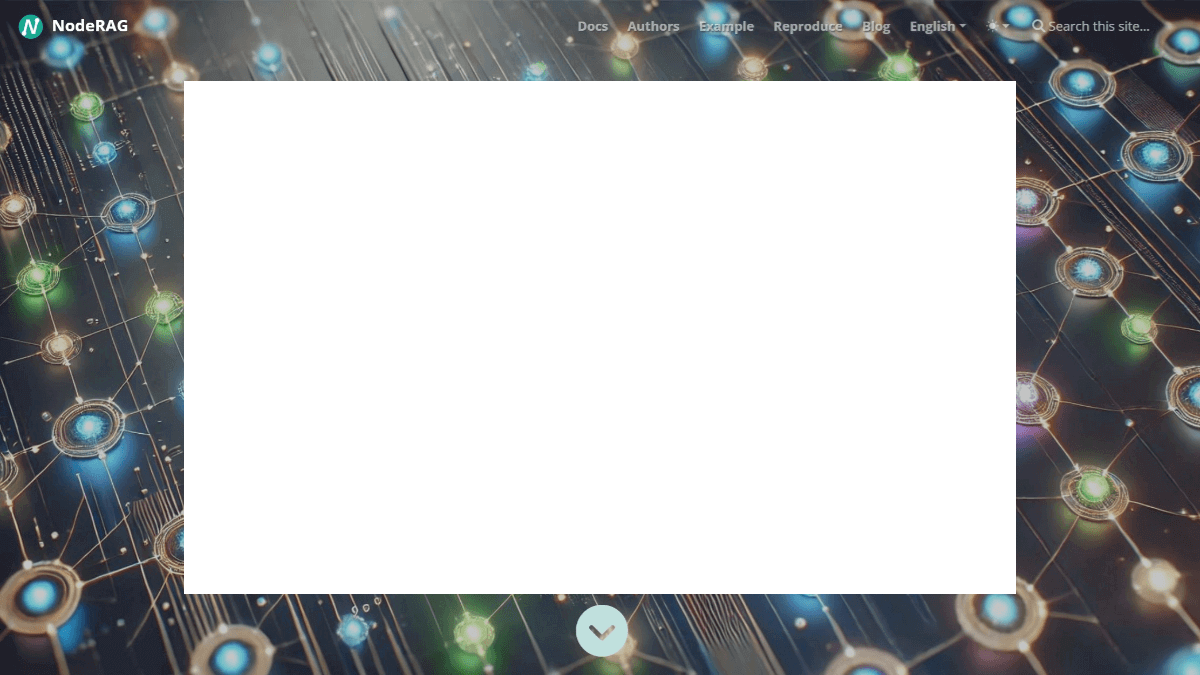NodeRag is a heterogeneous graph-based retrieval-augmented generation (RAG) system. It integrates document information and insights generated by language models by constructing heterogeneous graphs with multiple node types, supporting multi-hop retrieval and fine-grained information extraction. Noderag’s heterogeneous graph includes various node types such as entities, relationships, and semantic units, enabling context-aware retrieval and significantly improving retrieval accuracy and efficiency. The system supports incremental updates and can dynamically adapt to data changes, improving retrieval speed and performance through optimization algorithms.
 Key features of NodeRAG include:
Key features of NodeRAG include:
- Multi-hop information retrieval: By constructing heterogeneous graphs, NodeRAG supports multi-hop information retrieval. It is capable of extracting and integrating information from multiple nodes to solve complex query tasks. For example, in Multi-document Question Answering, NodeRAG can find relevant information scattered across different documents through multi-hop search and generate accurate answers.
- Fine-grained information extraction: NodeRAG’s heterogeneous graph contains a variety of node types (such as entities, relationships, semantic units, etc.), enabling fine-grained classification and organization of information. This allows the system to retrieve and extract relevant information more precisely, improving the interpretability of search results.
- Incremental update support:NodeRAG supports incremental updates to heterogeneous graphs, with the ability to dynamically add or modify nodes and edges. This allows the system to adapt to rapidly changing data environments, such as in the field of news, where new events and information can be integrated into the graph in a timely manner without the need to reconstruct the entire graph structure.
- Optimize performance and efficiency:NodeRAG is optimized for retrieval speed and storage efficiency. Through efficient indexing and query algorithms, NodeRAG enables rapid retrieval of information on large-scale datasets, reducing storage costs.
- Visualization and user interfaceNodeRAG offers a user-friendly visual interface and a full web UI that allows users to explore and manage heterogeneous diagrams graphically.
- Context-aware generationNodeRAG’s generation module leverages contextual information from heterogeneous graphs to generate more accurate and coherent text content. Combining the retrieved information with the generation capabilities of language models, NodeRAG is capable of generating high-quality text outputs, such as news summaries, Q&A answers, and more.
- Flexible deployment and scalingNodeRAG supports installation via Conda and PyPI, allowing users to easily deploy local web interfaces. NodeRAG’s architecture is designed to be flexible and scalable, supporting multiple languages and domains, making it suitable for various application scenarios such as news, finance, and healthcare.
NodeRAG’s technical principles include:
- Heterogeneous diagram structure designAt its core, NodeRAG is a heterogeneous graph structure that provides a comprehensive representation of knowledge within a corpus by integrating multiple types of nodes such as entities, relationships, semantic units, attributes, advanced elements, high-level overviews, and text nodes. Each node type assumes specific roles and functions, collectively forming a powerful and flexible graph structure.
-
Diagram construction process: The graph construction is divided into three main steps:
- Diagram breakdown: Use large language models to decompose text blocks into basic nodes such as semantic units, entities, and relationships, and construct the initial graph structure.
- Figure enhancement: Further enrich the graph structure and add advanced elements and attribute nodes through node importance evaluation (such as K-core decomposition and mediation centrality) and community detection (such as Leiden algorithm).
- Pictures are rich: Insert the original text block and selectively embed part of the data, use the Hierarchical Navigation Small World (HNSW) algorithm to organize the data into a multi-layer graph structure, and efficiently retrieve semantically similar nodes.
-
Graph search mechanism:NodeRAG uses a dual search mechanism and a shallow personalized PageRank (PPR) algorithm for efficient retrieval:
- Dual search mechanism: Combines exact matching on the header node and vector similarity search on the rich information node to identify the entry point in the graph.
- Shallow PPR algorithm: By simulating the random movement from the entry point, the relevant nodes are identified, and the number of iterations is limited through the early stop strategy to ensure that the correlation remains within the local range.
- Incremental update mechanism:NodeRAG supports incremental graph updates, and when new documents are added, the system can intelligently integrate new information into the existing graph structure without rebuilding the entire knowledge graph.
- Optimized sparse personalized PageRank:NodeRAG implements an optimized sparse personalized PageRank algorithm, which uses the sparse matrix computing power of SciPy to efficiently handle large-scale graph structures. This enables NodeRAG to efficiently calculate node importance on complex heterogeneous graphs and support accurate retrieval.
The project address of NodeRAG is:
- Github repository:https://www.php.cn/link/8012c113f03996cd9a5511baa835b83e
NodeRAG’s use cases include:
- Academic research: Researchers can use NodeRAG to organize literature data and build paper diagrams. By importing paper datasets, the system can extract keywords, authors, citation relationships and other information to generate a knowledge graph.
- Enterprise knowledge management: Enterprises can use NodeRAG to manage internal documents and build a knowledge base. By importing technical documents, project reports, etc., the system can generate document diagrams to help employees quickly locate the required information and improve the efficiency of knowledge sharing.
- Question and answer system in complex areas of knowledge: In professional fields such as medicine, law, finance, etc., NodeRAG’s heterogeneous graph structure can accurately capture professional concepts and their relationships, providing more accurate Q&A support.
- Personalized recommendation system: NodeRAG’s heterogeneous graphs can simultaneously model various information such as user preferences, product characteristics, and evaluation sentiment, capturing the complex relationships between them through graph structures and providing more accurate recommendations.
- Data analysis and visualizationData analysts can use NodeRAG to analyze complex datasets such asSocial networksor customer relationship data. The system visualizes data connections through graphs to help uncover hidden patterns, suitable for market analysis, risk assessment or recommendation system development.
The above is the detailed content of NodeRAG – an open source intelligent retrieval and generation system based on heterogeneous graphs, for more information, please pay attention to other related articles on the PHP Chinese website!